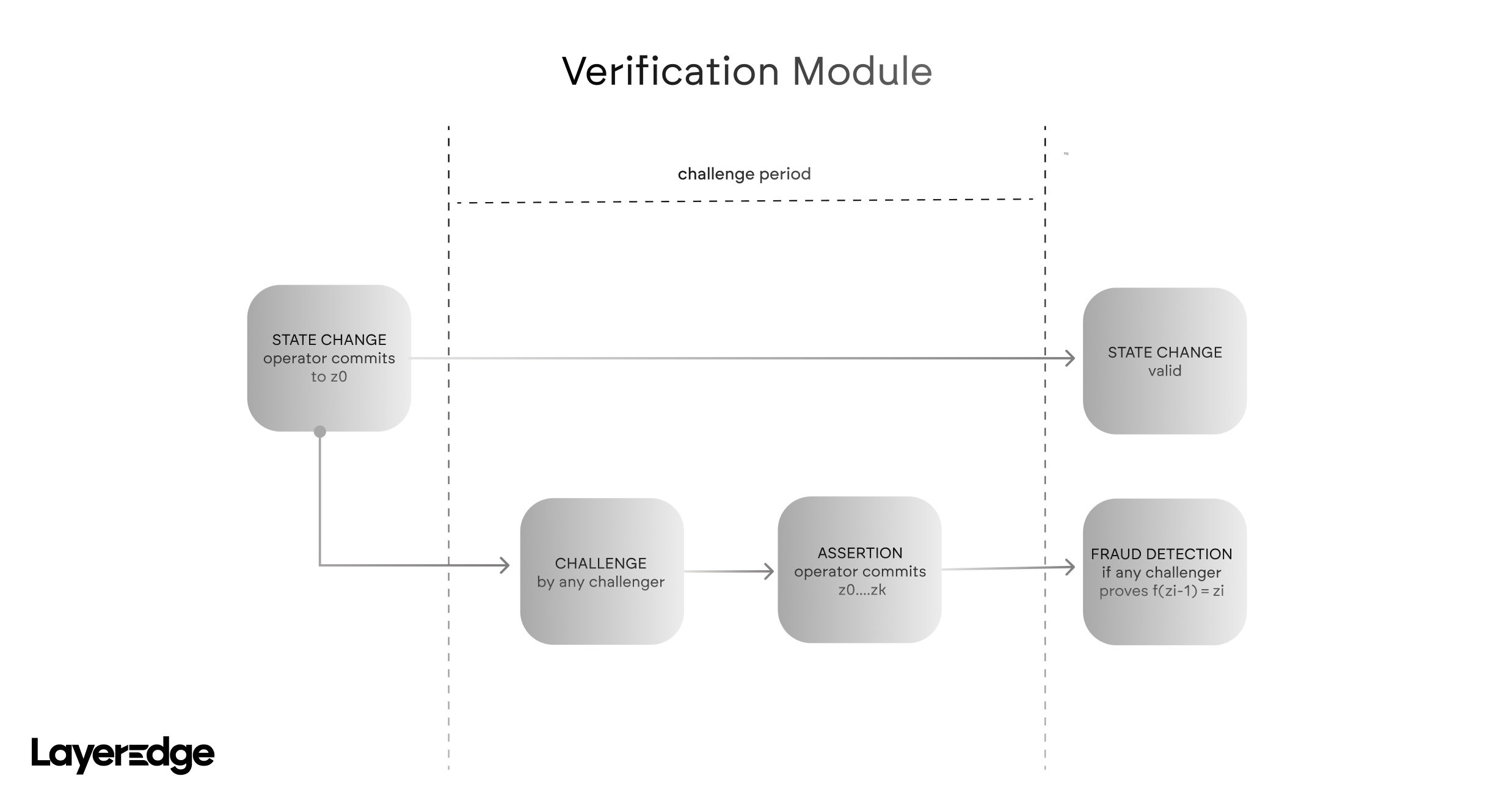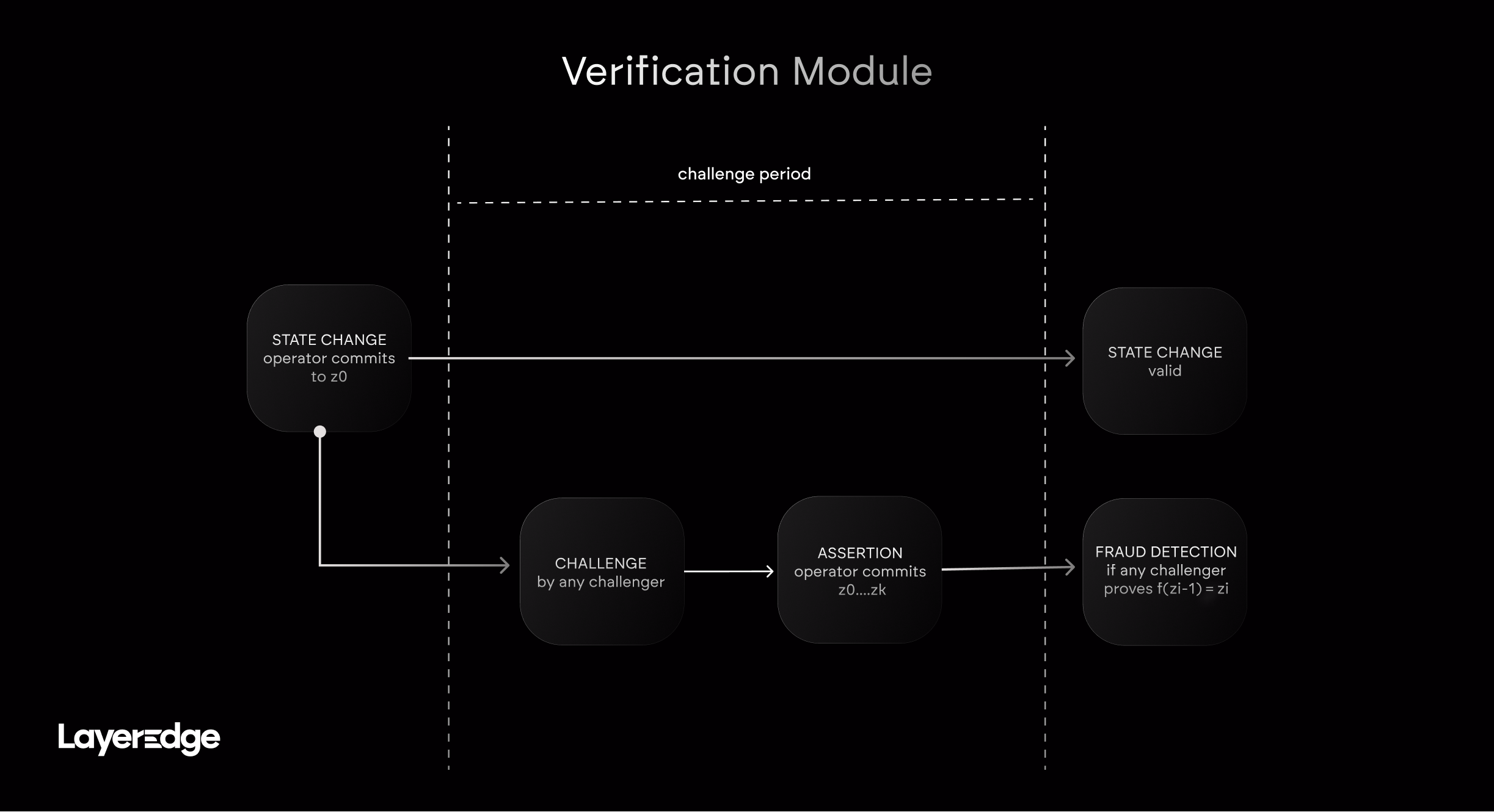Modular Verification on Bitcoin
LayerEdge supports modular verification of off-chain state transitions by splitting complex updates into verifiable sub-transitions, each backed by its own succinct proof. These sub-proofs (or their hashes/commitments) are anchored to Bitcoin periodically, ensuring tamper-evidence, transparency, and challengeability.
This modularity enhances granularity, scalability, and fault isolation within the State Transition Verification (STV) process.


Anchoring Sub-Transitions
Rather than representing an entire rollup state evolution with a single zk-proof, LayerEdge supports anchoring of multiple modular sub-proofs.
Each sub-transition has:
- Its own zk-SNARK or zk-STARK
- A commitment (e.g., Merkle leaf or direct hash)
- A timestamped anchoring operation on Bitcoin via Taproot, OP_RETURN, or in future, OP_CAT
These sub-proofs are periodically posted or committed to Bitcoin, offering an immutable checkpoint history of system state evolution.
Why Modular Proofs?
| Feature | Benefit |
|---|---|
| Granularity | Each sub-transition can be verified individually, enabling fine-grained fraud detection. |
| Parallelism | Independent sub-proofs can be computed, verified, and disputed in parallel — optimizing system throughput. |
| Challenge Efficiency | Disputes can be scoped to just one sub-transition instead of an entire batch or epoch. |
This model dramatically improves verification efficiency and fault tolerance in high-throughput environments.
Challenging a Transition
The system is designed for open verification and dispute resolution. If an entity observes any incorrect transition, they can initiate a formal challenge.
Detecting a Suspicious State
- Participants (e.g., Light Nodes or external watchtowers) constantly monitor the state roots and sub-transition commitments.
- If any proof appears malformed, incorrect, or inconsistent, they can trigger a challenge.
Submitting a Dispute — T_disprove
If a sub-transition appears invalid:
- A T_disprove transaction is posted on Bitcoin or LayerEdge's verification chain.
- This transaction includes:
- The index of the faulty sub-transition
- The raw data for re-verification
- A potentially contradictory proof or claim
The on-chain verifier logic is then triggered to compare the submitted proof to the expected transition function output.
Proving Fraud
If the sub-proof fails validation:
- The entire batch containing that sub-transition is invalidated
- The operator or aggregator is penalized
- The challenger is rewarded (see 4.3 for details on incentive design)
This approach ensures that fraudulent computation is always traceable and punishable, without forcing the system to re-check everything.
System Overview
| Feature | Description |
|---|---|
| Sub-Transition Splitting | State updates are broken into fine-grained components, each verifiable independently. |
| Anchoring Method | Each sub-proof or Merkle root is posted to Bitcoin (e.g., Taproot, OP_RETURN). |
| Dispute Flow | Any participant can challenge a specific sub-transition using T_disprove. |
| On-Chain Verification | Disputed proofs are re-verified on Bitcoin or LayerEdge chain with full cryptographic integrity. |
| Security Outcome | Invalid transitions lead to slashing of malicious actors and reward for challengers. |
Modular verification ensures that LayerEdge remains:
- Scalable: by parallelizing validation
- Auditable: through transparent proof anchoring
- Secure: with rapid, localized challenge resolution
It is a foundational design choice for enabling Bitcoin-anchored ZK computation that is robust, decentralized, and economically sustainable.